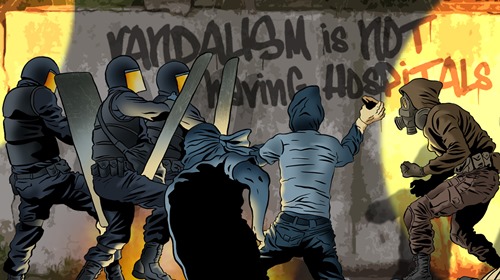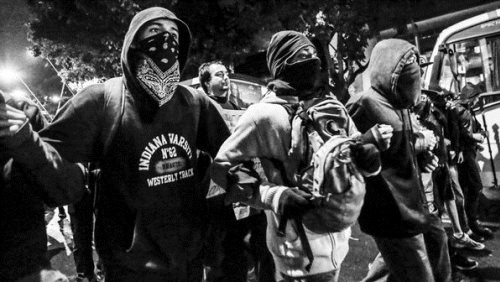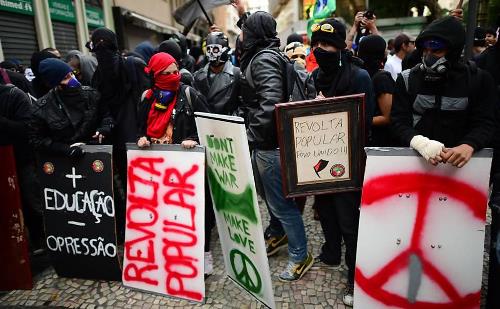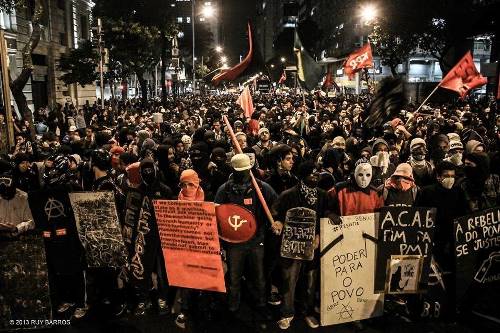by on June 23, 2014
Despised by many, hailed by some: the Black Bloc in Brazil uses its “performative violence” to draw attention to the everyday struggles of millions.
Article by Esther Solano Gallego and Paulo Rogério Lugoboni Filho. Illustration by Luciano Cunha, creator of O Doutrinador.
It was in the first weeks of the massive anti-government protests that started in June 2013 and shook Brazilian society to its very foundations that the Black Bloc made its first appearance on the protest scene. Demonstrations took place in dozens of cities across the country, but the black-clad youngsters who covered their faces and linked arms at the front-line of the marches, ready for any confrontation with the security forces, made their appearance mainly on the streets of São Paulo and Rio de Janeiro.
While being denounced by some for their violent tactics, actively looking for confrontations with the police and smashing banks and other symbols of global capitalism, those joining the Black Bloc in a protest could also count on some support from fellow protesters. During last year’s education crisis in October, which drew thousands of indignant teachers to the streets, the Black Bloc was present to protect them from the police violence.
In response, the SEPE Teacher’s Union declared its unconditional support for the Black Bloc, claiming that many have been protected by the masked youngsters from the excessive use of force by the police. Even though the SEPE has now retracted its support for the Black Bloc, and popular opinion has turned against it due to its negative depiction in the mainstream media, this strategy of radical anti-authoritarianism is still alive and kicking on the streets of Brazil today.
Despite the disproportional attention paid to the Black Bloc’s violence in the mainstream media, it is in fact still a largely marginal phenomenon. Even in a metropolis like São Paulo, where protest marches tend to draw in thousands of supporters, the Black Bloc usually does not consist of more than fifty to a hundred people.
Another flaw in the mainstream media’s reporting on the Black Bloc is its false presentation as an organization with a command structure, internal hierarchy and a clear agenda, whereas in fact it is nothing more than a tactic in which a group of like-minded people naturally flock together to resist the violence of the state, bound by the unconditional solidarity that lasts only as long as the protest itself, after which every individual goes their own way. In the words of some black bloc participants, the tactic has been described as a performance, a form of direct action that uses symbolic violence as a way to call for public debate.
Why so violent?
Ever since the Black Bloc entered the protest scene in Brazil, three crucial questions have intrigued observers and government officials alike: what motivates these people to take their anger to the streets; how do they justify the use of violence; and why do they not engage in peaceful protests?
Due to the explicit distrust that the majority of Black Bloc supporters have towards the media, especially the mainstream channels, it is really hard for society at large to obtain access to the ideologies and reasoning that guide their actions on the streets. The key, and most provocative, element that causes a big fuss in public opinion is the use of violence as a legitimate tool of protest. The arguments given by Black Bloc participants to justify their sometimes violent direct actions are essential to understanding all the dimensions of that phenomenon. Still, the ideological motivations and reasoning behind these actions is not well understood by the great majority of the population, whose only contact with the Black Bloc is through the mainstream media.
After talking with a number of Black Bloc participants, we can affirm that there exists a huge convergence between the beliefs of the protesters and the specific tactics generally used by the Black Bloc. Behind the heterogeneous profiles of these youths one can notice a common denominator; a collective idea that defines their shared points-of-view. First, there is the conviction that purely peaceful protests are not bringing any tangible results, and, as such, are inefficient.
In the words of one protester: “If we want peace, we have to fight for it. Peaceful protests are meaningless. The government doesn’t care! They only listen to violence.” This argument is closely related to the general discontent with the political institutions of the country. On top of this, there exists an intense anger towards the police and towards the military task forces in particular. “The military are murderers,” one protester told us. “They kill all the time and we can’t react. Military pigs!”
“Indignation” is the term that most frequently comes up when talking with the youths that are trying to explain the meaning of the Black Bloc to them. The feeling of indignation is instigated by the general discontent of the people with the political powers that are perceived as corrupt and absent in those sections of society where their presence is most urgently required.
The lack of high quality basic services, the difficult urban life, the disinterested stance of the political establishment, the uncertainties of the future, and the dismantlement of the public sector in contrast with the rise of the private sector are some of the examples continuously cited throughout the conversations we had with protesters. In this sense, the perception that today’s youth has of government and, in a broader sense, their perception of the current socio-economic system, closely mirrors public opinion.
Direct action
The Black Bloc is defined by its participants as a form of direct action. But what does this mean? In this particular case, the direct action of the Black Bloc can be seen as a form of both symbolic and performative violence against the symbols of corporate and state power. It is intended not to injure people but to still draw attention to the protests and provoke a social and institutional reaction. McDonald’s restaurants are vandalized, banks are left with broken windows, and government buildings are defaced: it all forms part of a collective tactic based on a theatrical display of confrontation with the powers-that-be.
Violence, in this way, can be considered a form of expression. It communicates to power a message that purely peaceful protests cannot, challenging the government and forcing it to bring about meaningful change. The bourgeois protests, or coxinhas, which are often entirely peaceful, have in the eyes of many failed to achieve any positive results for the population at large. For some, then, the use of performative violence — not oriented towards people but to property and, only in defensive battles, against the police — becomes necessary. One protester framed the violent protests as a warning signal to the government, which still refuses to address the protesters’ claims: “If violence isn’t used, you don’t get attention. They do not see our revolt.”
In this way, the use of performative violence is justified as a political instrument. According to these youths, the historical protests of June have not brought about any positive results or structural changes. Therefore, in order to advance to the next stage of the struggle, the form and content of the struggle needs to be radicalized by putting direct action at the heart of the movement’s tactics. This radicalization of the protests is a natural consequence of the refusal of public officials to engage with the popular will. Having reached the point at which the government clearly felt comfortable to simply ignore the peaceful marches of millions, performative violence is now perceived to be the only way for legitimate popular demands to be heard.
That said, the spectacular dimension of the protesters’ violence is a double-edged sword. On the one hand, the theatrical appeal of the violent protests for the mainstream media provides the protesters with a stage on which to display their message to a wider audience. On the other hand, it reinforces the media’s craving for the spectacle and thereby risks further marginalizing purely peaceful protests.
It is not uncommon for a protest where the Black Bloc makes its appearance to have an equal number of journalists, both from the mainstream channels and independent outlets, present on the scene. “We only gave attention to violent protests. That’s what matters,” admits Bruno Paes de Manso, a blogger for Estadão, one of the country’s largest newspapers. “The media creates a monster and then it doesn’t know what to do with it. We legitimize that violence. The peaceful protests don’t matter, they don’t sell and they can’t be turned into the front page of a newspaper.”
Now, with the FIFA World Cup-circus descending upon Brazil, the country’s resistance movement has the opportunity to showcase its grievances on a truly global stage. Different social forces are emerging in the face of this opportunity, and the tactics of the Black Bloc are becoming more and more popular. Even while being depicted in the media as a criminal organization, the Black Bloc gains strength inside the movement, mainly among those mobilizing against the tournament.
The battle at the doorstep
In the wake of the first birthday of the Marches of June, diversity of tactics now appears to have become a significant part of the political process in Brazil, capable of drawing attention to demonstrations that haven’t reached as wide an audience as last year’s mobilizations. This, in a sense, symbolizes a break-through with respect to the lethargic political reaction to last year’s protests — one that may yet prove to be a turning-point for Brazilian politics insofar as the development of a truly democratic society is concerned.
Perhaps most importantly, the rise of the Black Bloc forces us to confront the question of violence in a broader, more structural sense. Why do we pay such tremendous attention to some broken windows, while no one is talking about the 50.000 annual homicides, or the equal amount of women who are raped every year in Brazil? Does the theatrical violence of the Black Bloc truly deserve more attention than the tragedies of everyday life in the favelas? One explanation is that the performative violence of the Black Bloc has brought the battle to the doorstep of those who are pulling the strings, whereas the very real violence against the poor and marginalized occurs at the fringes of society, safely hidden away from the public gaze in areas where the cameras of the mainstream media rarely venture.
Whether one agrees with Black Bloc tactics or not, we have to admit that they successfully draw attention to the very real indignation that slumbers below the surface of Brazilian society. We can debate how successful the use of performative violence can be in achieving one’s long-term goals of radical social transformation, but we cannot deny a person’s right to resist in whatever way they see fit. When violence is the only face of the state that people experience, no wonder it’s through violence that they resist.
Esther Solano Gallego is Professor of International Relations at the Federal University of São Paulo.
Paulo Rogério Lugoboni Filho is a student in International Relations at the Federal University of São Paulo
Luciano Cunha is a Brazilian author, cartoonist and graphic designer. His latest creation is the anti-hero O Doutrinador (‘The Indoctrinator’), who — dressed in black, sporting a Sepultura t-shirt, carrying a machine gun and with his face covered by a gas mask to avoid identification — has set out on a mission to rid the country of its corrupt politicians. In less than a year the comic has drawn a lot of attention from infuriated Brazilians who in some way feel connected to the anti-hero’s mission. The popularity of O Doutrinador has sky-rocketed in the past year, drawing attention not only from those who support Cunha’s work, but also from government figures who attempt to muzzle him via lawsuits, violating his freedom of expression and trying to kill his creative liberty. We at ROAR are therefore very excited to feature a series of unique drawings by Cunha to illustrate our Brazil coverage in the coming weeks. O Doutrinador can be found on Facebook, YouTube, and his personal website.
Quelle: RoarMag




